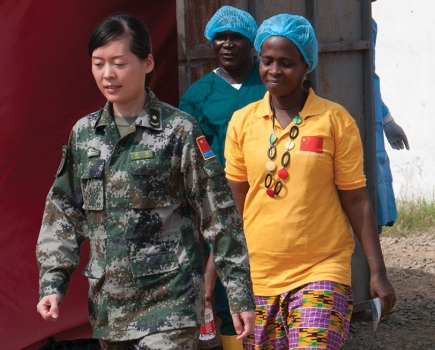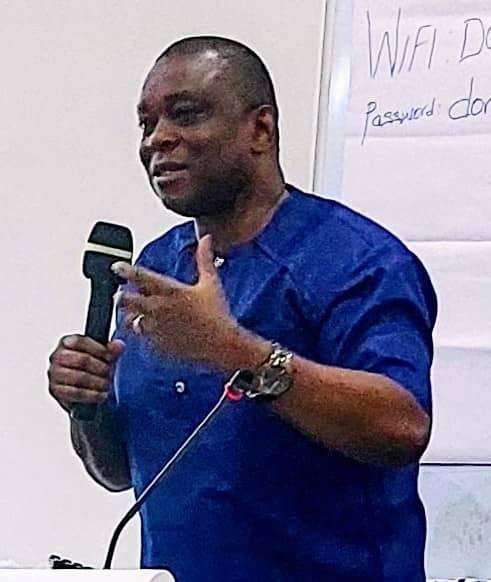Ebola: A bumpy road to zero transmission
Liberia, Guinea and Sierra Leone remain vigilant as infections decline in the three countries
Paolo Conteh, Sierra Leone’s defence minister and head of the country’s National Ebola Response Centre, was an athlete who set a 400-metres national record in 1982 that remains unbeaten to this day. These days, Mr. Conteh uses a sporting analogy to explain the fight against the Ebola virus disease, which has resulted in more than 22,000 infections and over 9,000 deaths in the three most affected countries of Sierra Leone, Liberia, and Guinea. (Photo: Beatrice Yardolo, right, Liberia’s last Ebola patient, walks out of the Chinese Ebola Treatment Unit (ETU) in Monrovia, Liberia, at the beginning of a short ceremony celebrating her survival and release from the ETU on March 5. Photo: UNMEER/Simon Ruf)
At a discussion forum in the Sierra Leonean capital, Freetown, in January, the moderator asked Mr. Conteh to explain the state of Ebola then.
“Let’s put it this way,” the former sprinter began. “We are running a 400m race and we have just 20m to go. Already, your legs are tiring and you are gasping for breath. Other runners are coming fast and are about to overtake you. But you must finish the race strong. At that stage, you dig deeper and draw on your last reserves of energy. You must do all you can to breast the victory tape.”
Although there were some chuckles in the audience that included 80 Ebola social mobilizers, who are in communities sensitizing people on Ebola, the message was clear: the race against Ebola cannot be won unless there is a strong, final push.
Declining transmission
On the ground, there is a strong sense of imminent victory in the three most affected countries. Medical practitioners, contact tracers, burial teams, surveillance teams, social mobilizers, logistics providers, and others working to end the virus are in a somewhat boisterous mood. Compared with the figures in the last months of 2014, Ebola transmission has declined significantly.
“We have moved from a phase where we were being hounded and hunted to a situation where we are now hunting Ebola,” said Amadu Kamara, former Sierra Leone’s Crisis Manager for the UN Mission for Ebola Emergency Response (UNMEER).
By the end of January 2015, there were only three patients in the African Union-run Magbinthi Treatment Centre, in northern Sierra Leone. “With few Ebola patients, we are planning to start treating others who test negative to Ebola but may have other illnesses,” the coordinator of the Centre, Dr. John Ssentanu, told Africa Renewal then. They were treating diseases such as malaria or typhoid until the clinic was finally shut down in February.
The sudden decline in Ebola transmission is a welcome surprise. The US, which had sent some 2,800 troops to Liberia, announced in mid-February that its troops would pull out by the end of April 2015. “We have bent the curve of the epidemic and placed it on a much improved trajectory,” read a White House statement.
Storm in a tea cup
But it was just in September 2014 that the US Centers for Disease Control and Prevention (CDC) predicted that there could be 1.4 million Ebola cases in Africa by 20 January 2015. With a projected 70% fatality, that could have meant about a million deaths. While some experts say that the doomsday scenario was a storm in a tea cup because it was not based on any proper epidemiological analysis, Martin Meltzer, who led the CDC study, insists that projections were made “on the assumption that no further interventions and no further changes in human behavior would take place. We knew, or we very much hoped that we would be wrong.”
However, there is a downside to the declining transmission numbers. “We are no longer seeing the buckets of chlorinated water in shops, supermarkets and other places. People are becoming tired and stubborn,” says Monte Jones, a special adviser to Sierra Leonean President Ernest Koroma.
In Guinea, President Alpha Condé also warned: “It’s precisely because things are getting better that we have to stay vigilant in order to get to zero cases,” adding that there should be no room for complacency.
The leaders of the Liberia, Guinea and Sierra Leone are walking a tightrope, trying to return their countries to normal life yet warning that the Ebola fight was not over yet. Last November, Liberia lifted the state of emergency declared in the wake of high transmission and reopened schools in mid-February 2015. Sierra Leone eased travel and trade restrictions and reopened schools in March.
But in response to a recent spike in new cases, the government put 25 government hospitals on special duty with new infection and prevention control (IPC) units—the first of their kind in the country.
On the road to zero
Even though “zero” is the buzzword in the three most affected countries, the World Health Organization (WHO) protocols stipulate that a country can only be declared Ebola-free if it records zero transmission and has had no new cases for another 42 days from the day it records zero cases.
At an extraordinary meeting in February 2015, presidents Ellen Johnson Sirleaf of Liberia, Koroma and Condé and a representative of President Alassane Ouattara of Côte d’Ivoire met under the umbrella of the Mano River Union (MRU), a sub-regional grouping, and resolved to arrive at zero infections within 60 days. That would mean until mid-April 2015. The leaders hoped to get support from foreign partners, intensify social mobilization and surveillance, enhance coordination and provide mental and psychosocial support to victims.
If these countries achieve zero transmission by mid-April, the 42-day countdown would lead to end of May. If so, then, hopefully, Sierra Leone, Liberia and Guinea – perhaps the world – could be declared Ebola-free.
Setting a 60-day target is the easy part; achieving it is much more difficult. “We are going to have a bumpy road to zero,” said Mr. Kamara, the former crisis manager of UNMEER in Sierra Leone. “We should not expect a linear progression. There will be a few surprises along the way.”
A presentation by Dr. Daniel Kertesz, the then WHO Sierra Leone representative, reinforces Mr. Amadu’s prognosis. Drawing from previous outbreaks in Gulu in Uganda and Booué in Gabon, Dr. Kertesz said that the tail end of an Ebola outbreak “can have a bumpy landing; can last for two to three months; or can get to zero and recur.”
Dr. Kertesz said any decline in transmission should be treated with caution as should any spikes. “We are not in control of the epidemic yet. Recent cases demonstrate that quiet areas can flare up if we miss or lose control of chains of transmission.”
Sub-regional dimension
The sub-regional dimension of Ebola also complicates the race to zero transmission. MRU’s secretary-general Saran Daraba Kaba says Ebola cannot be defeated unless its regional implications are addressed.
The MRU countries have a combined population of 45 million of which 2.2 million are engaged in cross-border activities such as trading and transportation, according to a report by the union. In addition, border communities forge socio-economic and cultural relationships. “This has led to a situation where suspected border [Ebola] cases and confirmed cases have moved across borders in public road transport or even on foot,” notes the report.
The MRU is therefore urging member states to regulate how patients, corpses and laboratory samples are transferred across borders. Defence minister Conteh agrees with the MRU, even adding that if Liberia has zero cases and no transmission for 42 days, the country should not be considered Ebola-free until Sierra Leone and Guinea attained similar status. The virus should be treated as “one epidemic with many fronts,” concurs Mr. Kamara.
Meanwhile, individual countries may keep an eye on happenings across their borders, but it doesn’t stop them from crowing about progress. Liberia, Guinea and Sierra Leone – and indeed the world –are hoping that very soon every county, every district and every country will be Ebola-free.
By Kingsley Ighobor in Freetown, Sierra Leone, courtesy of Africa Renewal
Stay with Sierra Express Media, for your trusted place in news!
© 2015, https:. All rights reserved.







Musa Kilimanjaro
/
its a long road to zero ebola transmissions but much progress has been made already
9th April 2015